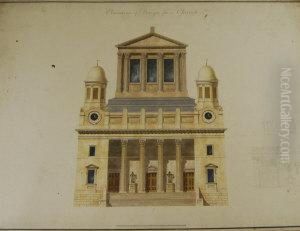Robert Mylne Paintings
Robert Mylne was a British architect and engineer, renowned for his work during the 18th century. Born on January 4, 1733, in Edinburgh, Scotland, Mylne came from a family with a strong tradition in stonemasonry and architecture that can be traced back to the 16th century. His grandfather, Robert Mylne (1633–1710), was a master mason to the Crown of Scotland. Mylne was educated as an architect and engineer and spent a significant period of his early career in Italy, where he studied under the mentorship of prominent figures and was influenced by the classical architecture of the Renaissance.
During his time in Italy, Mylne won the competition for the design of the new Blackfriars Bridge in London in 1759. This became one of his most famous works and marked a significant achievement in his career. The bridge was completed in 1769 and stood for over a century before being replaced. Mylne's design was praised for its combination of utility and aesthetic elegance, reflecting the principles of Palladian architecture.
Mylne was also a prolific builder and engineer and was involved in numerous other projects. He worked on the design and construction of several buildings, canals, and other engineering works throughout Britain. His architectural style often featured neoclassical elements, which were popular at the time, and he contributed to the development of Georgian architecture in the UK.
Apart from his architectural endeavors, Mylne held the position of surveyor to the New River Company, which supplied fresh water to London, from 1761 until his death. In this capacity, he was responsible for overseeing the maintenance and expansion of the water supply network, which was vital for the growing metropolis.
Robert Mylne passed away on May 5, 1811, in London. His legacy is reflected in the enduring quality of his work and his contribution to British architecture and engineering. He was succeeded by his nephew, William Chadwell Mylne, who was also an architect and engineer. The Mylne family continued to have a significant impact on the field for generations. Robert Mylne's Blackfriars Bridge, although no longer standing, remains an important chapter in the history of London's development and a testament to the skill and ingenuity of its creator.
